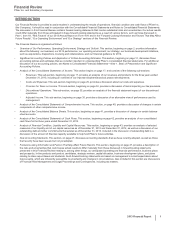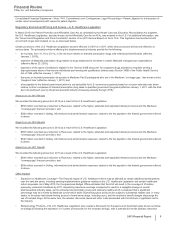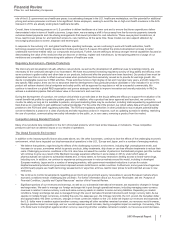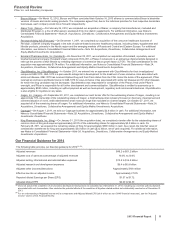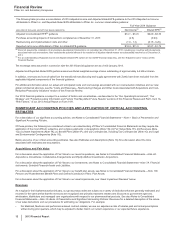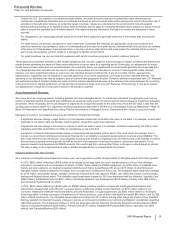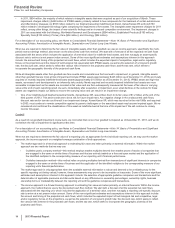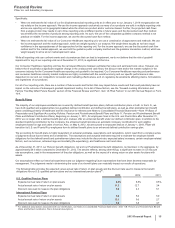Pfizer 2013 Annual Report Download - page 6
Download and view the complete annual report
Please find page 6 of the 2013 Pfizer annual report below. You can navigate through the pages in the report by either clicking on the pages listed below, or by using the keyword search tool below to find specific information within the annual report.
Financial Review
Pfizer Inc. and Subsidiary Companies
2013 Financial Report
5
Consolidated Financial Statements––Note 17A1. Commitments and Contingencies: Legal Proceedings––Patent Litigation for a discussion of
certain recent developments with respect to patent litigation.
Regulatory Environment/Pricing and Access––U.S. Healthcare Legislation
In March 2010, the Patient Protection and Affordable Care Act, as amended by the Health Care and Education Reconciliation Act (together,
the U.S. Healthcare Legislation, and also known as the Affordable Care Act or ACA), was enacted in the U.S. For additional information, see
the “Government Regulation and Price Constraints” section of our 2013 Annual Report on Form 10-K. This legislation has resulted in both
current and longer-term impacts on us, as discussed below.
Certain provisions of the U.S. Healthcare Legislation became effective in 2010 or in 2011, while other provisions will become effective on
various dates. The principal provisions affecting the biopharmaceutical industry provide for the following:
• an increase, from 15.1% to 23.1%, in the minimum rebate on branded prescription drugs sold to Medicaid beneficiaries (effective
January 1, 2010);
• extension of Medicaid prescription drug rebates to drugs dispensed to enrollees in certain Medicaid managed care organizations
(effective March 23, 2010);
• expansion of the types of institutions eligible for the “Section 340B discounts” for outpatient drugs provided to hospitals serving a
disproportionate share of low-income individuals and meeting the qualification criteria under Section 340B of the Public Health Service
Act of 1944 (effective January 1, 2010);
• discounts on branded prescription drug sales to Medicare Part D participants who are in the Medicare “coverage gap,” also known as the
“doughnut hole” (effective January 1, 2011); and
• a fee payable to the federal government (which is not deductible for U.S. income tax purposes) based on our prior-calendar-year share
relative to other companies of branded prescription drug sales to specified government programs (effective January 1, 2011, with the total
fee to be paid each year by the pharmaceutical industry increasing annually through 2018).
Impacts on our 2013 Results
We recorded the following amounts in 2013 as a result of the U.S. Healthcare Legislation:
• $458 million recorded as a reduction to Revenues, related to the higher, extended and expanded rebate provisions and the Medicare
“coverage gap” discount provision; and
• $280 million recorded in Selling, informational and administrative expenses, related to the fee payable to the federal government referred
to above.
Impacts on our 2012 Results
We recorded the following amounts in 2012 as a result of the U.S. Healthcare Legislation:
• $593 million recorded as a reduction to Revenues, related to the higher, extended and expanded rebate provisions and the Medicare
“coverage gap” discount provision; and
• $336 million recorded in Selling, informational and administrative expenses, related to the fee payable to the federal government referred
to above.
Impacts on our 2011 Results
We recorded the following amounts in 2011 as a result of the U.S. Healthcare Legislation:
• $648 million recorded as a reduction to Revenues, related to the higher, extended and expanded rebate provisions and the Medicare
“coverage gap” discount provision; and
• $248 million recorded in Selling, informational and administrative expenses, related to the fee payable to the federal government referred
to above.
Other Impacts
• Expansion of Healthcare Coverage—The financial impact of U.S. healthcare reform may be affected by certain additional developments
over the next few years, including pending implementation guidance relating to the U.S. Healthcare Legislation and certain healthcare
reform proposals. As of May 2013, the Congressional Budget Office estimates that the ACA will result in the coverage of 25 million
previously uninsured individuals by 2017. Expanding insurance coverage is expected to result in a negligible change in overall
pharmaceutical industry sales, as the uninsured are principally young and relatively healthy and it is expected that a significant
percentage may be covered by Medicaid (under which sales of pharmaceutical products are subject to substantial rebates and, in many
states, to formulary restrictions limiting access to brand-name drugs, including ours), and the restrictive benefit designs discourage the
use of branded drugs. At the same time, the rebates, discounts, taxes and other costs associated with the ACA are a significant cost to
the industry.
• Biotechnology Products—The U.S. Healthcare Legislation also created a framework for the approval of biosimilars (also known as follow-
on biologics) following the expiration of 12 years of exclusivity for the innovator biologic, with a potential six-month pediatric extension.


